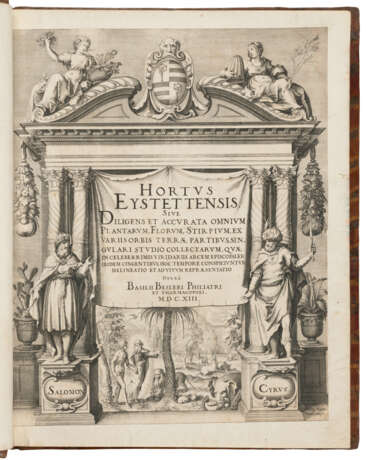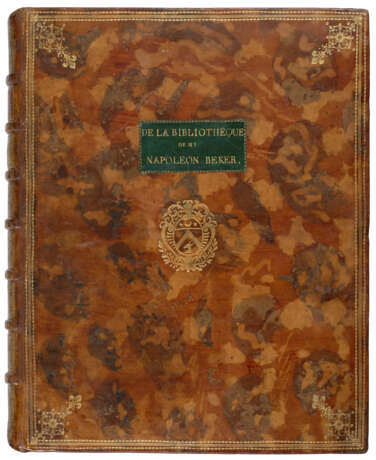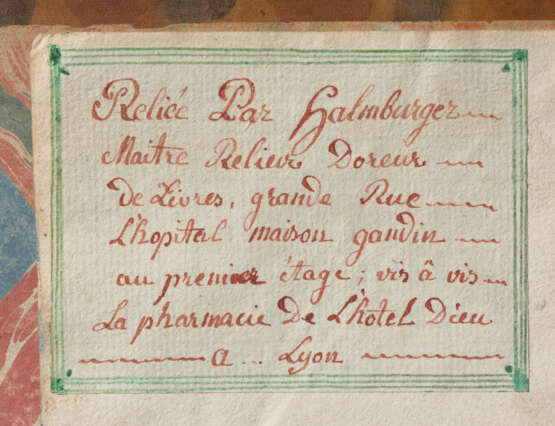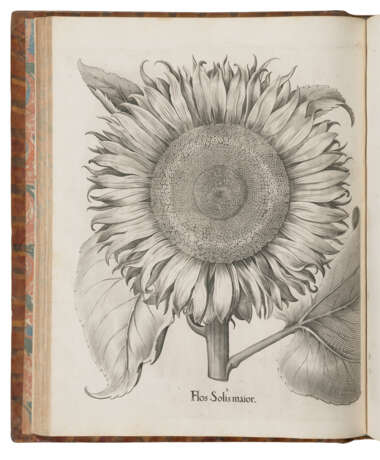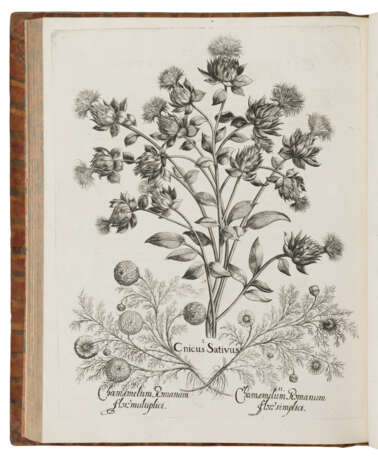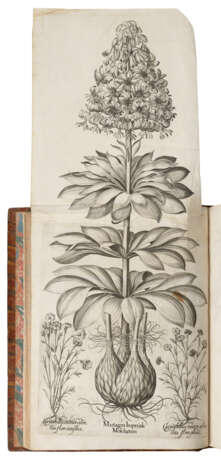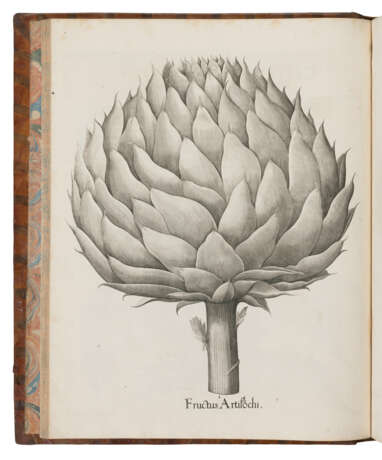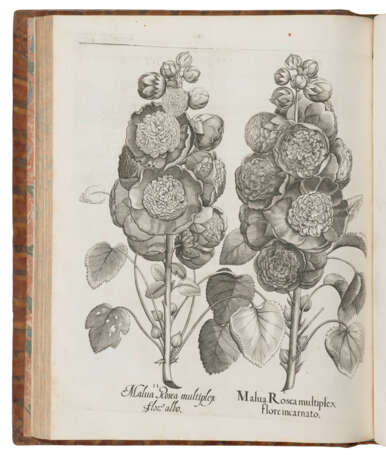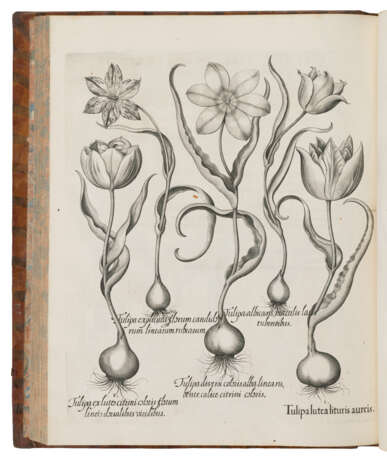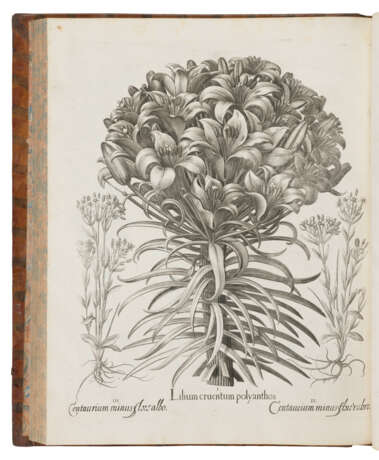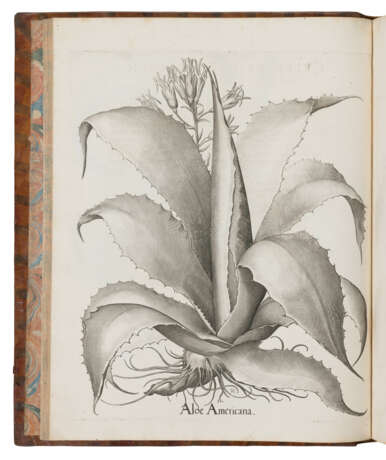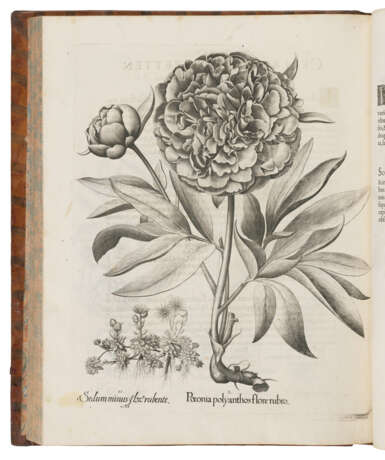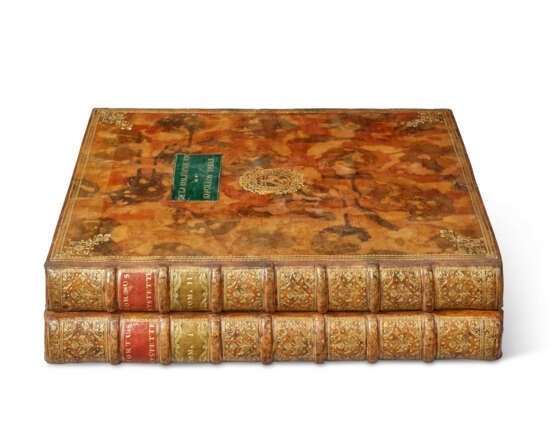ID 794413
Lot 184 | BESLER, Basilius (1561-1629)
Estimate value
£ 250 000 – 350 000
Hortus Eystettensis. [Nuremberg]: 1613.
First edition, uncoloured issue, complete with descriptive text, of the most magnificent florilegium ever published. Before the end of the century, this copy was in Paris in the collection of Mathieu-François Geoffroy, pharmacist at Paris, and subsequently rebound by Halmburger for the prestigious Gavinet collection at Lyons. Antone-Nicolas Gavinet and his father Jean-Marie formed an extensive library specialising in botanical, chemistry and natural science books. Both men were noted chemists and Antoine-Nicolas was a member of the Academy of Sciences at Lyon. After the revolution the volume joined the collection of Napoleon Beker.
The Hortus Eystettensis is a pictorial record of the flowers grown in the greatest German garden of its time, that of the Prince Bishop of Eichstätt, Johann Conrad von Gemmingen. At the Willibaldsburg castle, his seat above the river Altmühl, the Prince Bishop created an extensive pleasure garden comprising eight separate gardens, each with its own gardeners and each filled with flowers from a different country; in tulips alone he boasted of 500 colours. The great German botanist, Joachim Camerarius the Younger, served the Prince Bishop as advisor on the garden's early design and on his death in 1598 a Nuremberg apothecary, Basilius Besler took on the role. It was Besler who had the garden immortalised in detailed and delicate engravings for the year-round enjoyment of his patron and for posterity in the Hortus Eystettensis.
The book was conceived on a grand scale. Flowers were drawn from life; copperplate engravings were made by the most skilled engravers such as Wolfgang Kilian; and the plates were printed on large-format, royal paper sheets. The first edition of 300 copies was published in two issues: one without the text, usually finely coloured, and one with descriptive text printed on the versos of the engraved plates, as here, intended to be sold via regular trade channels, for which Besler was responsible and through which he could realise his ambition of gaining 'fame and profit'. These uncoloured copies, while more common, show off the delicacy and detail of the engravings, which rate among the greatest botanical illustrations ever printed.
The original drawings used in preparing the plates for publication survive at the University of Erlangen, and 328 of the copperplates, long thought to have been melted at the Munich mint c.1820, were rediscovered in the Albertina Graphische Sammlung at Vienna in 1998. Antoine Halmburger is known as a binder at Lyons in the rue de l’Hopital by 1786; in 1793 Francoise-Antoine was condemned to the guillotine, and the bindery was continued by his descendants and remained active well into the 19th century. Cf. N. Barker Hortus Eystettensis, The Bishop's Garden and Besler's Magnificent Book, New York: 1995. Hunt 430 (1713 edition); Nissen BBI 158; Oak Spring Flora 11; Pritzel 745; Stafleu and Cowan 497.
2 volumes, royal broadsheet folio (552 x 446mm). Engraved title by Wolfgang Kilian, 4 engraved season titles, engraved portrait of Besler with his coat-of-arms, and 367 engraved botanical plates by Wolfgang Kilian, Dominicus Custos, Raphael Custos, Georg Gärtner, Johann Leypold, Levin van Hulsen, Friedrick van Hulsen, Peter Isselburg, Servatius Raeven, Heinrich Ulrich and possibly others, after Daniel Herzog, Georg Gärtner and others. Letterpress: dedication to Johann Conrad, Prince Bishop of Eichstätt, dedications to the Dean and College of Medicine at Nuremberg and to the reader, 2 leaves of privileges for France, Belgium and the Netherlands in roman, italic, or gothic type, index leaves bound after each relevant part (summer AA-HH; autumn aa-cc; winter A; spring A-D, AA-CC), text printed on plate versos. (Title and winter title trimmed to plate edge and mounted, neat repairs in portrait leaf, one plate partly remargined, 2 text leaves reinforced at fore-margin, very occasional small spot or marginal stain, very few short marginal tears.) Bound at Lyons by Halmburger, with his ms ticket in each volume: 18th-century mottled calf gilt, Gavinet arms [Olivier 142] at centre, gilt spine with red and green labels, edges marbled and gilt, marbled endleaves, flyleaves with watermark of four ewers within a circle (or IHS) and L. Bloys countermark (cf. Heawood 3262, Paris 1694), 19th-century green label lettered ‘De la Bibliothèque de Mr. Napoleon Beker.’ on front covers (discreet repairs at extremities). Provenance: Mathieu-François Geoffroy, pharmacist at Paris, inscription dated Paris, 1678 – [Jean-Marie et Antoine-Nicolas (1724-95)] Gavinet, chemist and pharmacist at Lyon (binding) – Napoleon Beker (d.1829, staff officer in French royal army and son of Nicolas Leonard Beker; ex-libris label on front covers) – Johannishus Bibliotek (engraved bookplate).
Special notice
No VAT on hammer price or buyer's premium.
| Place of origin: | Western Europe, Germany, Europe |
|---|---|
| Auction house category: | Printed books |
| Place of origin: | Western Europe, Germany, Europe |
|---|---|
| Auction house category: | Printed books |
| Address of auction |
CHRISTIE'S 8 King Street, St. James's SW1Y 6QT London United Kingdom | |
|---|---|---|
| Preview |
| |
| Phone | +44 (0)20 7839 9060 | |
| Buyer Premium | see on Website | |
| Conditions of purchase | Conditions of purchase |
